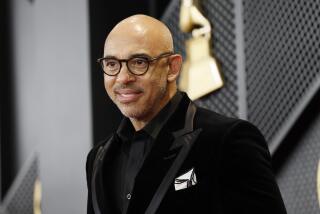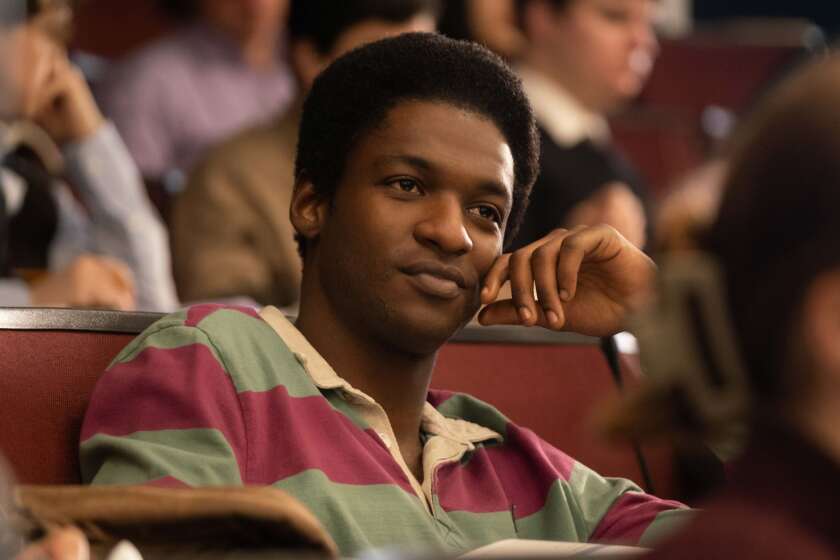Cheryl Boone Isaacs is ready for the spotlight
As a teenager in the 1960s, Cheryl Boone Isaacs would often spend summers visiting her older brother, an advertising and publicity executive at United Artists in New York City. He would leave her in a screening room to watch movies all day long, fueling her love of film — and a career ambition.
After graduating from Whittier College, she landed a job at Columbia Pictures as a film publicist. She remembers pinching herself when she first walked onto the studio lot, then in Burbank. Later, she moved to publicity at Paramount Pictures, and as her career advanced she became a member of the Academy of Motion Picture Arts and Sciences in 1987.
She cried then, and on Tuesday night the tears flowed again when she was elected the first African American president of the movie industry’s most prominent organization. Her appointment signals that the academy, long criticized as too old and too white, is actively seeking to diversify its leadership ranks in terms of race and gender.
INSIDE THE ACADEMY: Who’s who among the members
“I know it’s big news, and I knew it would be big news,” Isaacs, 63, said Wednesday morning. “But it’s a good thing. We have increased the diversity with the inclusion of new members, and we are going to continue on this road. It’s very important to me.”
Isaacs is the third woman president in the 86-year history of the group, which puts on the annual Oscar telecast.
Although the academy employs a chief executive, Dawn Hudson, who oversees day-to-day operations, the president is the public face of the group, appearing on the Oscar show, running board meetings and managing membership issues.
The first item on Isaacs’ agenda will be helping producers Craig Zadan and Neil Meron select a host for the 2014 Academy Awards.
Another big part of her job will involve the fundraising and design plans for the academy’s $300-million movie museum, slated to open in 2017.
The coming year will be a big one, with the expected hiring of a curatorial staff and groundbreaking on the site at the Los Angeles County Museum of Art campus. Isaacs said she also intends to continue efforts to involve more of the academy’s 6,000 members in the group’s wide range of activities.
Oscars 2013: Winners | Highlights
Isaacs is used to breaking barriers in Hollywood — she was the first African American woman to run a studio marketing department in 1997 when she joined New Line Cinema as its president of theatrical marketing — and she attributes her success to perseverance and dedication.
“With both situations, I worked very hard and had great support from staff and leadership wherever I worked. When I got the job at New Line it was a big first and the same thing here,” she said.
A 2012 Los Angeles Times study found that Oscar voters were 94% white and 77% male with African Americans representing 2% of the academy. The median age of Oscar voters was 62. But a new class of 276 members, admitted last month, appears to be much more diverse.
In choosing Isaacs, who is now an independent marketing consultant, the academy’s board of governors selected a loyal, behind-the-scenes operator over the higher profile studio executive Rob Friedman, co-chairman of Lionsgate’s motion picture group.
Isaacs, a native of western Massachusetts, joined the board in 1988 and has served in every position throughout her 25 years volunteering within the organization. Most recently, she produced last year’s Governors Awards, a non-televised ceremony that recognizes recipients of honorary Oscars.
“She has a real knowledge of the motion picture community, and she really wanted to protect the legacy of these people we were honoring,” said veteran producer Don Mischer, who worked with Isaacs on the ceremony. “She helped us find the little surprises we could use when honoring them.”
TIMELINE: Academy Awards through the years
As an example, Mischer recalled that it was Isaacs’ idea to invite 102-year-old animator Ruthie Thompson to help give a tribute to DreamWorks Animation Chief Executive Jeffrey Katzenberg. (Thompson lives at the Motion Picture Home in Calabasas, and Katzenberg is a key fundraiser for the retirement facility.)
“She was a good leader and guided us through the show,” Mischer said.
Several people who have worked with Isaacs describe her as an active listener yet someone with strong opinions who isn’t afraid to let herself be heard. Jeff Blake, now vice chairman of Sony Pictures, recalled working with Isaacs during her tenure at Paramount when she was involved in the campaigns for “Forrest Gump” and “Braveheart.”
“I think she’s a very smart woman that really understands the film business,” said Blake. “She was not afraid to stand up for what she felt was the best route to go. I think she will be really good for this role.”
Though the president’s post is unpaid, Isaacs intends to treat the role like a full-time job, as did her recent predecessors, Hawk Koch and Tom Sherak. That’s a change from the earlier days of the academy, when luminaries such as Gregory Peck and Karl Malden helmed the nonprofit and brought a lot of attention to the group but did little in terms of oversight.
For Isaacs, whose term is one year but who will be eligible for reelection, it will be the chance to give back to a place she’s spent many years.
PHOTOS: Hollywood backlot moments
“It’s one thing to be an officer and to be involved quite a bit,” said Isaacs. “It’s another to be president. I’m diving into this full time.”
Isaacs’ ascension to the academy presidency also appears to be part of a movement to include a wider range of professional backgrounds among the organization’s top officers.
The group also named costume designer Jeffrey Kurland and make-up artist Leonard Engelman to vice president positions — posts that have often been occupied by members from splashier branches like producers and screenwriters. And in another step toward making the tent bigger, the academy formed a new branch for casting directors (previously, they could only join as members-at-large).
“This academy is now represented across the board,” said former academy president Sid Ganis, referring to the inclusion of Engelman and Kurland. “Both above-the-line people and below-the-line people are now running the organization. That’s how it should be. That’s what it takes to make a movie.”
¿
More to Read
Only good movies
Get the Indie Focus newsletter, Mark Olsen's weekly guide to the world of cinema.
You may occasionally receive promotional content from the Los Angeles Times.










